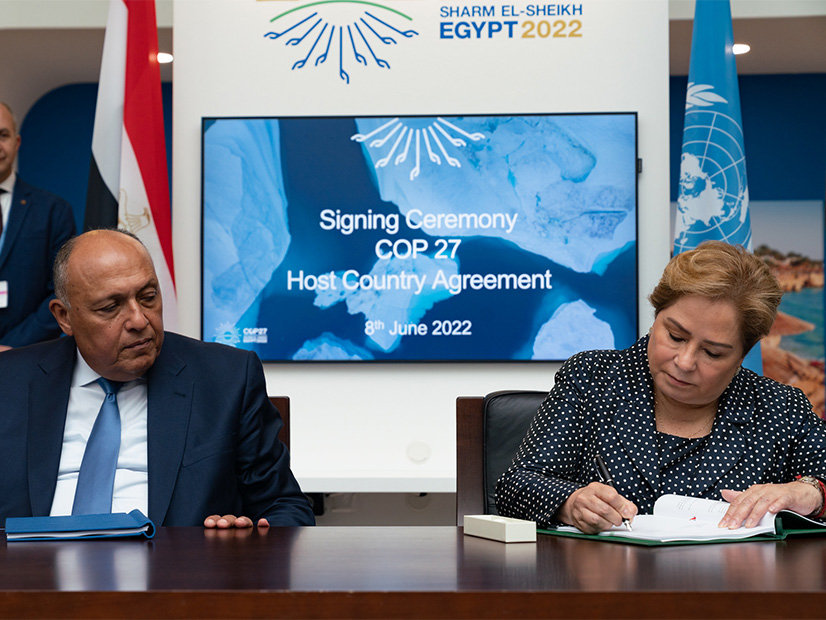
The leadership for the U.N.’s 27th Climate Change Conference of the Parties (COP27) is preparing a new guide for Paris Agreement signatories on just financing that it will release at the conference in Sharm El-Sheikh, Egypt, this fall.
“The idea is to capitalize on the needed interplay between different stakeholders in order to promote an actionable climate agenda and achieve scale financing,” Nada Tawfik, senior adviser for strategic planning at Egypt’s Ministry of International Cooperation, said Wednesday.
The Sharm El-Sheikh Guidebook for Just Financing will highlight the role in global climate financing of different stakeholders, such as multilateral development banks (MDBs), philanthropies, private-sector entities and climate funds, said Tawfik during an E3G-hosted webinar for London Climate Action Week.
Key goals of the guide are to: map the global climate finance landscape; identify key stakeholders and their complementary roles and competitive edge; and target priority sectors that have a direct impact on accelerating climate action.
“Recent statistics have … shown that the climate financing that has been mobilized in 2021 mainly was targeting [greenhouse gas emission] mitigation sectors,” Tawfik said. “In this guidebook, we aim to strike a balance between adaptation and mitigation and pinpoint opportunities to accelerate climate action.”
The guide will provide an international framework for climate action that applies to all developing and emerging counties, while also detailing implementable regional actions.
“The role of the different stakeholders would be important for creating an enabling environment for climate investment, enhancing the invest-ability of green projects and thinking of innovative ways to de-risk investments and bring in financing at scale,” Tawfik said.
The COP27 presidency’s preparation committee is holding discussions now with multiple stakeholder groups, which includes MDBs, to discuss “a pipeline of implementable projects on the national level” for the guide, she said.
Key Strategies
In preparing the guide, the COP27 leadership wanted to show how MDBs can instigate investments by the private sector.
“MDBs play an important role in providing financing and technical support; however, this financing is not enough to meet the recent estimates of more than $4 trillion in order to finance the [global] climate action agenda” through 2030, Tawfik said.
An MDB is a financial institution established by a group of countries to support developing countries. The U.S., for example, is a member of five MDBs, which include the World Bank, Inter-American Development Bank, Asian Development Bank, African Development Bank and European Bank for Reconstruction and Development (EBRD).
Nationally determined contributions (NDCs) and long-term low GHG emission development strategies, as the building blocks of the Paris Agreement, are important levers in MBDs’ ability to support developing countries. An NDC, which is a five-year climate plan of a party to the Paris Agreement, does not have the time frames that MDBs need to plan for climate investments, according to Jan-Willem van de Ven, head of international climate policy and engagement at EBRD.
“It’s very good that the Paris Agreement found this instrument of long-term strategies [LTSes], because the long-term strategies are where the analysis, synthesis and objectives can come together on a longer time pathway,” van de Ven said. “We know that if [MDBs] invest in infrastructure, these are typically investments with payback times of more than 10 years.”
The current challenge, he added, is that more countries need to “ramp up” work on their LTSes and submit them to the U.N.
To date, 51 countries have submitted an LTS, and only 30 of those are countries with coordinated economic development goals as members of the Organization for Economic Co-operation and Development, according to Marcela Jaramillo, senior associate at the 2050 Pathways Platform. The U.S. submitted a pathway for net-zero GHG emissions by 2050 during COP26 last fall.
An additional 60 countries are working on their strategies, and Jaramillo says many of those governments expect to submit a strategy in September. Others in that group may continue to work on their strategies and present them at the 28th Conference of the Parties (COP28) in 2023 in Dubai, United Arab Emirates.
“The LTS process really takes time to bring everyone to the table, build consensus and have conversations on this vision of the country,” Jaramillo said.
The U.N. climate change secretariat will release a report on all the strategies submitted by September for review at COP27. That report will allow parties to the Paris Agreement to look at the strategies in relation to the goal of holding global temperature rise to below 1.5 degrees Celsius, said Tom Evans, a researcher at E3G.
It will take another year, however, to really understand the scope of LTSes and their impact. Evans sees COP28 as the next “important moment” for working on those strategies and giving parties clear instructions for moving their climate goals forward.